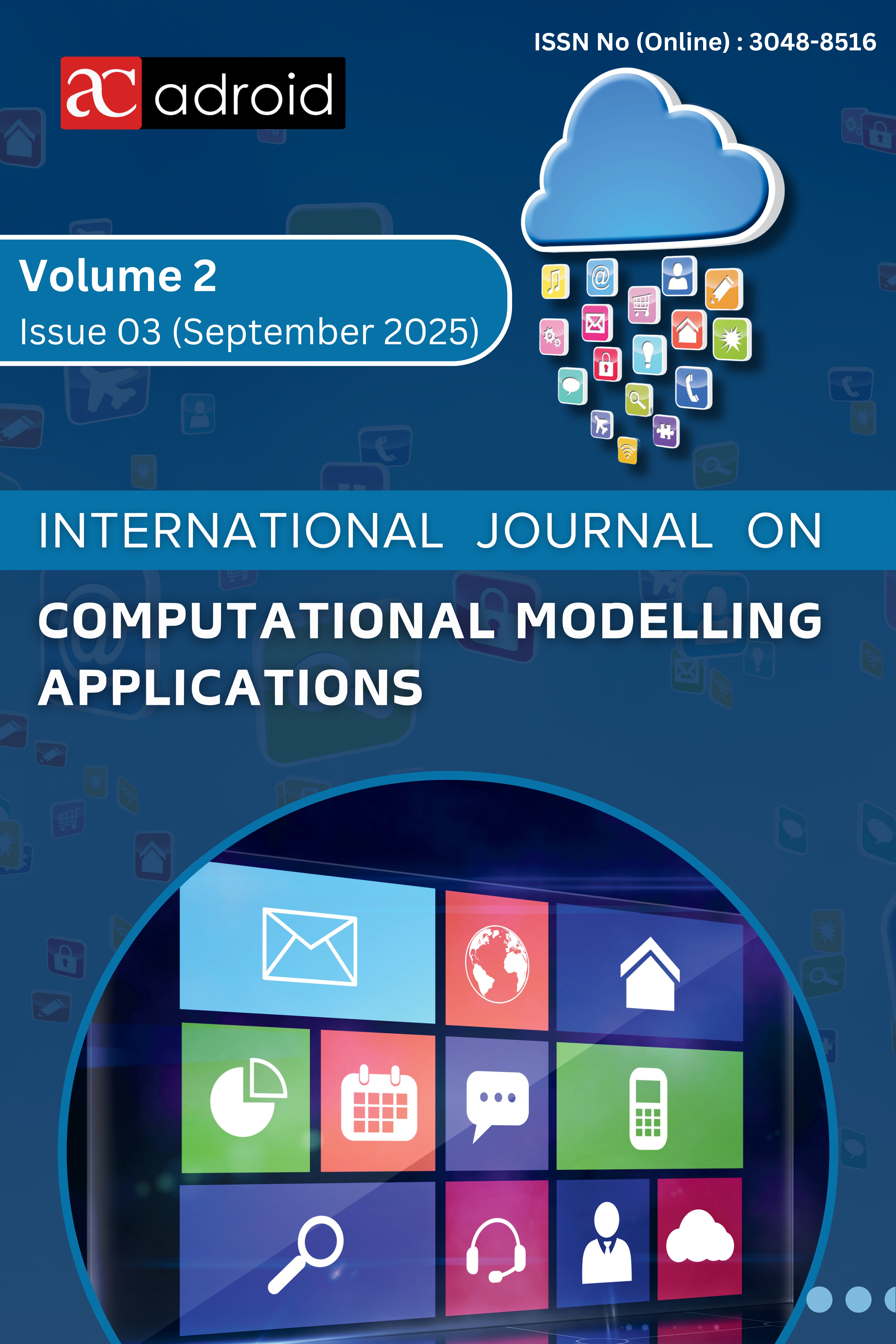Bio-Inspired Computational Models for Multi-Objective Optimization in Complex Engineering Systems
DOI:
https://doi.org/10.63503/j.ijcma.2025.171Keywords:
Bio-inspired computation, Multi-objective optimization, Evolutionary algorithms, Swarm intelligence, Hybrid metaheuristics, Pareto optimality, Engineering system designAbstract
Multi-objective optimization is now an indispensable tool in engineering and scientific practice, where two or more conflicting objectives have to be optimized subject to complex constraints. The classic evolutionary algorithms (EAs) and swarm intelligence (SI) schemes are competitive, but have many disadvantages, including early convergence, low diversity maintenance, and extreme expensive computational requirements, especially in high-dimensional spaces. To limit these shortcomings, this paper presents a hybrid bio-inspired optimization model that combines genetic algorithm (GA) crossover-mutation operators, particle swarm optimization (PSO) velocity-position updates, and differential evolution (DE) mutation strategies, and adaptive parameter control. The hybridization makes use of the exploration capability of GA, the fast convergence of PSO, and the strong local search of DE to be able to achieve a faster convergence and better diversity across the Pareto front. The framework is tested on six benchmark functions (ZDT1-ZDT6) as well as a real-world welded beam design problem. Experimental evidence indicates that the suggested method performs better than NSGA-II, MOPSO and MODE in terms of average hypervolume increase of 7.8 %, convergence time decreases on average by 12.5% , and spread diversity improves by 35 %. The results indicate that the framework suggested offers a scalable and a robust approach to solving complex multi-objective optimization problems.
References
[1] Hakanen, J., & Allmendinger, R. (2021). Multiobjective optimization and decision making in engineering sciences. Optimization and Engineering, 22(2), 1031-1037. https://doi.org/10.1007/s11081-021-09627-x
[2] Deb, K. (2011). Multi-objective optimisation using evolutionary algorithms: an introduction. In Multi-objective evolutionary optimisation for product design and manufacturing (pp. 3-34). London: Springer London. https://doi.org/10.1007/978-0-85729-652-8_1
[3] Deb, K., Pratap, A., Agarwal, S., & Meyarivan, T. A. M. T. (2002). A fast and elitist multiobjective genetic algorithm: NSGA-II. IEEE transactions on evolutionary computation, 6(2), 182-197. doi: 10.1109/4235.996017
[4] Kennedy, J., & Eberhart, R. (1995, November). Particle swarm optimization. In Proceedings of ICNN'95-international conference on neural networks (Vol. 4, pp. 1942-1948). ieee. doi: 10.1109/ICNN.1995.488968
[5] Eberhart, R. C., & Shi, Y. (2000, July). Comparing inertia weights and constriction factors in particle swarm optimization. In Proceedings of the 2000 congress on evolutionary computation. CEC00 (Cat. No. 00TH8512) (Vol. 1, pp. 84-88). IEEE. doi: 10.1109/CEC.2000.870279
[6] Czyzżak, P., & Jaszkiewicz, A. (1998). Pareto simulated annealing—a metaheuristic technique for multiple‐objective combinatorial optimization. Journal of multi‐criteria decision analysis, 7(1), 34-47. https://doi.org/10.1002/(SICI)1099-1360(199801)7:1<34::AID-MCDA161>3.0.CO;2-6
[7] Janga Reddy, M., & Nagesh Kumar, D. (2007). An efficient multi-objective optimization algorithm based on swarm intelligence for engineering design. Engineering Optimization, 39(1), 49-68. https://doi.org/10.1080/03052150600930493
[8] Sarkar, M., & Roy, T. K. (2018). Optimization of welded beam structure using neutrosophic optimization technique: a comparative study. International Journal of Fuzzy Systems, 20(3), 847-860. https://doi.org/10.1007/s40815-017-0362-6
[9] Yıldız, A. R., Öztürk, N., Kaya, N., & Öztürk, F. (2007). Hybrid multi-objective shape design optimization using Taguchi’s method and genetic algorithm. Structural and Multidisciplinary Optimization, 34(4), 317-332.
https://doi.org/10.1007/s00158-006-0079-x
[10] Roy, S., Martínez, S. Z., Coello, C. A. C., & Sengupta, S. (2012, June). A multi-objective evolutionary approach for linear antenna array design and synthesis. In 2012 IEEE Congress on Evolutionary Computation (pp. 1-8). IEEE. doi: 10.1109/CEC.2012.6252989
[11] Zouache, D., Abdelaziz, F. B., Lefkir, M., & Chalabi, N. E. H. (2021). Guided Moth–Flame optimiser for multi-objective optimization problems. Annals of Operations Research, 296(1), 877-899. https://doi.org/10.1007/s10479-019-03407-8
[12] Bhatt, P. K. (2022). Harmonics mitigated multi-objective energy optimization in PV integrated rural distribution network using modified TLBO algorithm. Renewable Energy Focus, 40, 13-22. https://doi.org/10.1016/j.ref.2021.11.001
[13] Zhang, Y., Li, B., Hong, W., & Zhou, A. (2023). MOCPSO: A multi-objective cooperative particle swarm optimization algorithm with dual search strategies. Neurocomputing, 562, 126892. https://doi.org/10.1016/j.neucom.2023.126892
[14] Marano, G. C., Quaranta, G., & Greco, R. (2009). Multi-objective optimization by genetic algorithm of structural systems subject to random vibrations. Structural and multidisciplinary optimization, 39(4), 385-399. https://doi.org/10.1007/s00158-008-0330-8
[15] Zhang, Y., Wang, S., & Ji, G. (2015). A comprehensive survey on particle swarm optimization algorithm and its applications. Mathematical problems in engineering, 2015(1), 931256. https://doi.org/10.1155/2015/931256
[16] Garg, H. (2016). A hybrid PSO-GA algorithm for constrained optimization problems. Applied Mathematics and Computation, 274, 292-305. https://doi.org/10.1016/j.amc.2015.11.001
[17] Lin, A., Liu, D., Li, Z., Hasanien, H. M., & Shi, Y. (2023). Heterogeneous differential evolution particle swarm optimization with local search. Complex & Intelligent Systems, 9(6), 6905-6925. https://doi.org/10.1007/s40747-023-01082-8
[18] Mohanty, A., & Yao, B. (2010). Indirect adaptive robust control of hydraulic manipulators with accurate parameter estimates. IEEE Transactions on Control Systems Technology, 19(3), 567-575. doi: 10.1109/TCST.2010.2048569
[19] Panyam, V., Huang, H., Davis, K., & Layton, A. (2019). Bio-inspired design for robust power grid networks. Applied Energy, 251, 113349. https://doi.org/10.1016/j.apenergy.2019.113349
[20] Mandal, A. K., Sarma, P. K. D., Dehuri, S., & Mazumdar, N. (2024). Bioinspired Machine Learning: A New Era in Sustainable Energy Systems. Biomass and Solar‐Powered Sustainable Digital Cities, 57-80. https://doi.org/10.1002/9781394249374.ch6
[21] Maraveas, C., Asteris, P. G., Arvanitis, K. G., Bartzanas, T., & Loukatos, D. (2023). Application of bio and nature-inspired algorithms in agricultural engineering. Archives of Computational Methods in Engineering, 30(3), 1979-2012. https://doi.org/10.1007/s11831-022-09857-x
[22] Yondo, R., Bobrowski, K., Andrés, E., & Valero, E. (2018). A review of surrogate modeling techniques for aerodynamic analysis and optimization: current limitations and future challenges in industry. Advances in evolutionary and deterministic methods for design, optimization and control in engineering and sciences, 19-33. https://doi.org/10.1007/978-3-319-89988-6_2
[23] Hamid, M., Anisurrahman, & Alam, B. (2025). Quantum Machine Learning for Drug Discovery: A Systematic Review. International Journal on Computational Modelling Applications, 2(3), 01–08. https://doi.org/10.63503/j.ijcma.2025.156
[24] Sandeep Singh Sikarwar. (2025). Computation Intelligence Techniques for Security in IoT Devices. International Journal on Computational Modelling Applications, 2(1), 15–27. https://doi.org/10.63503/j.ijcma.2025.48

